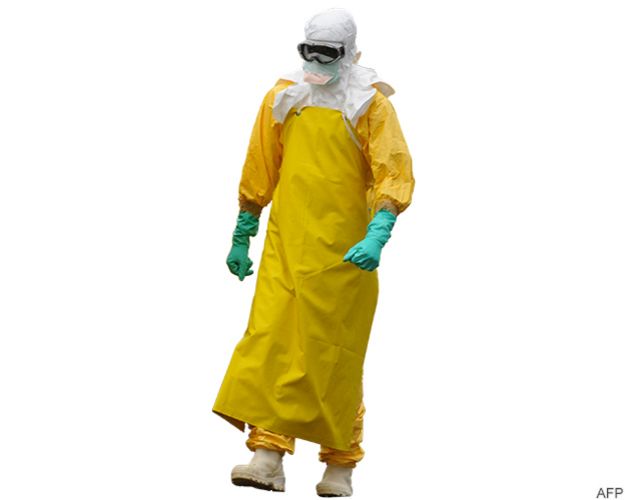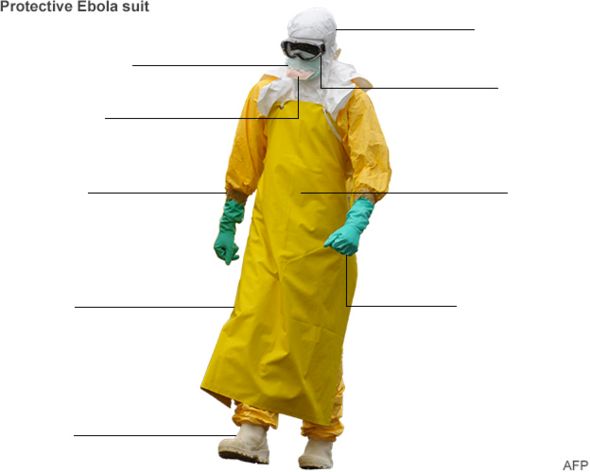 Mr Duncan, shown here at a 2011 wedding in Ghana
Mr Duncan, shown here at a 2011 wedding in Ghana
The first person to be diagnosed with Ebola within the US has died, Texas hospital officials have said.
Thomas Eric Duncan, 42, who caught the virus in his native Liberia, was being treated with an experimental drug in isolation in a Dallas hospital.
Earlier the US announced new screening measures at entry points to check travellers for symptoms of the virus.
It has killed 3,865 people, mostly in Liberia, Sierra Leone and Guinea, in the worst Ebola outbreak yet.
"It is with profound sadness and heartfelt disappointment that we must inform you of the death of Thomas Eric Duncan this morning at 7:51 am," a spokesman for Texas Health Presbyterian Hospital in Dallas said in a statement.
"Our thoughts today are with his family," said US President Barack Obama, who said his death showed "we don't have a lot of margin for error. If we don't follow protocols and procedures that are put in place, then we're putting folks in our communities at risk."
The news came shortly after US Secretary of State John Kerry urged all nations to boost their response to combat the virus.
"More countries can and must step up," he said in a joint press conference with his British counterpart Philip Hammond.
"Ebola is an urgent global crisis that demands an urgent global response."
The US has pledged as many as 4,000 troops to the region, while the UK is sending 750 military personnel to Sierra Leone.
Duncan, who worked as a driver for a courier company, tested positive in Dallas, Texas, on 30 September, 10 days after arriving on a flight from Monrovia via Brussels.
He become ill a few days after arriving in the US but even after going to hospital and telling medical staff he had been in Liberia he was sent home with antibiotics.
How will US airport screening work?
- JFK in New York, Newark in New Jersey, Washington Dulles, O'Hare in Chicago and Atlanta's Hartsfield-Jackson
- They account for 90% of international travellers to the US
- About 160 people come daily from Sierra Leone, Liberia and Guinea
- A handheld device will take temperatures
- Passengers will also have to fill out a questionnaire
- passengers with a fever or who answer "yes" to certain questions will be seen by a representative of the Centers for Disease Control and Prevention
Four days later, he was placed in isolation but his condition continued to worsen and this week he was given an experimental drug.
Ten people with whom he came into contact are being monitored for symptoms.
Following Duncan's diagnosis, the first case of contagion outside of Africa was confirmed in Spain, where a nurse who treated an Ebola victim in Madrid contracted the virus herself.
The BBC's Lucy Williamson: Spanish authorities have been criticised after the nurse contracted Ebola in the country's best-equipped quarantine unit
Teresa Romero is the first person known to have contracted the deadly virus outside West Africa.
She had treated two Spanish missionaries who later died from Ebola.
In other developments:
- The UK is sending 750 troops to Sierra Leone to help build Ebola treatment centre
- The World Bank has warned that the economic cost of the virus could exceed $32bn (£20bn)
While Duncan was the first person to be diagnosed within the US, three American aid workers and a photojournalist contracted the virus in Liberia. Three have recovered.
The new screening measures in Chicago, New York, Washington and Atlanta would not have detected Duncan's infection because he was not displaying symptoms on arrival.
Ebola spreads through contact with the bodily fluids of someone who has the virus and the only way to stop an outbreak is to isolate those who are infected.
INTERACTIVE
Protective Ebola suit
×
Goggles
×Goggles, or eye visors, are used to provide cover to the eyes, protecting them from splashes. The goggles are sprayed with an anti-fogging solution before being worn.Medical mask
×Covers the mouth to protect from sprays of blood or body fluids from patients. When wearing a respirator, the medical worker must tear this outer mask to allow the respirator through.Respirator
×A respirator is worn to protect the wearer from a patient's coughs. According to guidelines from the medical charity Medecins Sans Frontieres (MSF), the respirator should be put on second, right after donning the overalls.Medical Scrubs
×A surgical scrub suit, durable hospital clothing that absorbs liquid and is easily cleaned, is worn as a baselayer underneath the overalls. It is normally tucked into rubber boots to ensure no skin is exposed.Overalls
×The overalls are placed on top of the scrubs. These suits are similar to hazardous material (hazmat) suits worn in toxic environments. The team member supervising the process should check that the equipment is not damaged.Double gloves
×A minimum two sets of gloves are required, placed over the suit sleeves. Medical workers must change gloves between patients, performing thorough hand hygiene before donning a new pair. Heavy duty gloves are used whenever workers need to handle infectious waste.Apron
×A waterproof apron is placed on top of the overalls as a final layer of protective clothing.Boots
×Ebola health workers typically wear rubber boots, with the scrubs tucked into the footwear. If boots are unavailable, workers must wear closed, puncture and fluid-resistant shoes.Surgical cap
×The cap forms part of a protective hood covering the head and neck. It offers medical workers an added layer of protection, ensuring that they cannot touch any part of their face whilst in the treatment centre.

- Symptoms include high fever, bleeding and central nervous system damage
- Spread by body fluids, such as blood and saliva
- Fatality rate can reach 90% - but current outbreak has mortality rate of about 70%
- Incubation period is two to 21 days
- There is no proven vaccine or cure
- Supportive care such as rehydrating patients who have diarrhoea and vomiting can help recovery
- Fruit bats, a delicacy for some West Africans, are considered to be virus's natural host

 How not to catch Ebola
How not to catch Ebola How Ebola attacks
How Ebola attacks
No comments:
Post a Comment